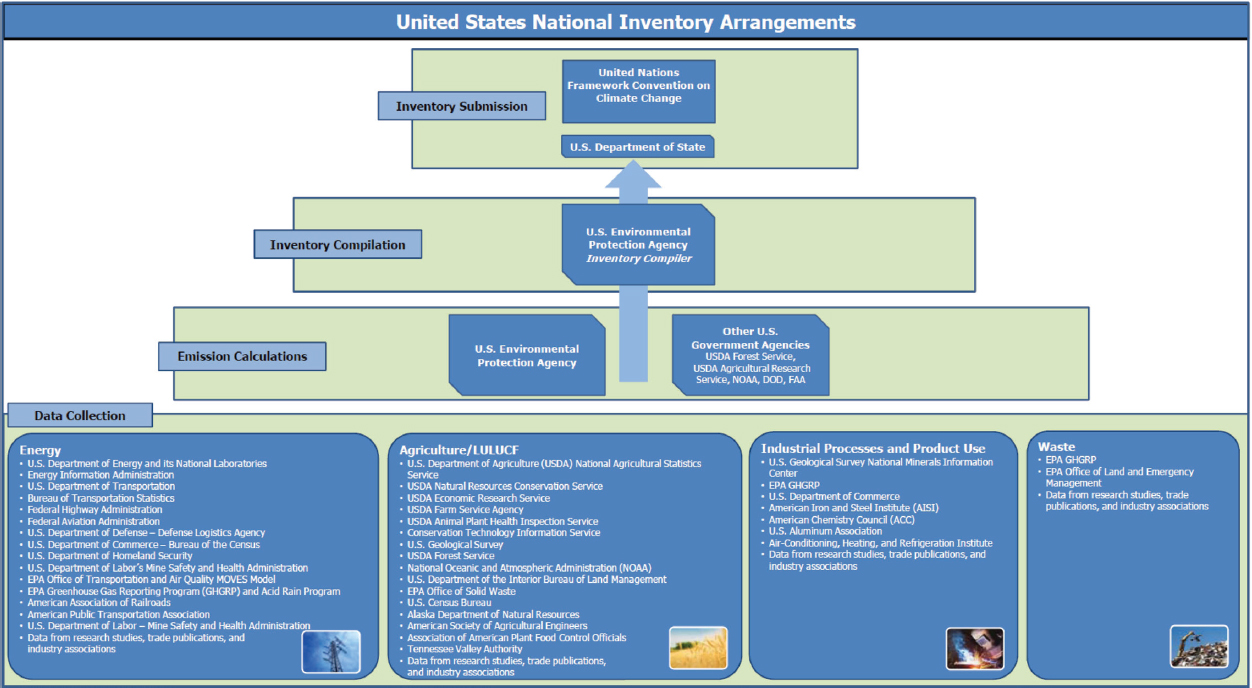APPENDIX D
U.S. Greenhouse Gas Inventory Development
PRINCIPLES OF GREENHOUSE GAS INVENTORY DEVELOPMENT
Key to understanding the emission numbers contained in the annual U.S. Greenhouse Gas Inventory (GHGI) is understanding the principles upon which the inventory is developed:
- Inclusion of anthropogenic emissions from sources and removals by sinks: The GHGI covers all human-induced greenhouse gas (GHG) emissions not controlled by the Montreal Protocol; at a minimum, the inventory must include emissions of carbon dioxide (CO2), methane (CH4), nitrous oxide (N2O), perfluorocarbons (PFCs), hydrofluorocarbons (HFCs), sulfur hexafluoride (SF6), and nitrogen trifluoride (NF3) across all sectors of the economy (energy; industrial processes and product use; agriculture, land use, land use change, and forestry [LULUCF]; and the waste sector). In the case of the LULUCF sector, anthropogenic emissions and removals are considered to be those arising from managed lands, while those arising from unmanaged lands are considered natural emissions and therefore excluded from the GHGI.
- Reporting of actual emissions: The inventory methods result in an estimate of the GHG emissions in the year in which they occur; that is, the methods result in actual emissions to the atmosphere and not potential emissions that may be released from the source over a period of years.
- Full territorial coverage: The GHGI covers the entire United States and its territories.
-
Use of the 2006 IPCC Guidelines: The 2006 Intergovernmental Panel on Climate Change (IPCC) Guidelines outline a tiered approach for estimating GHG emissions from each source or sink of anthropogenic emissions. There are generally three tiers for estimating emissions for each category:
- Tier 1 broadly relies on multiplying activity data (AD) by an international default factor representing emissions per unit of activity;
- Tier 2 approaches generally involve the application of a region- or country-specific emission factors to national- or regional-level AD;
- Tier 3 approaches are more detailed, involving further stratification of the AD, estimates from process-based models, plant-level emission estimates, direct measurement, or other equivalent country-specific approaches.
- Ensuring the inventory is transparent, accurate, consistent, comparable, and complete.
- Transparency: The data sources, assumptions, and methodologies used in the inventory should be clearly explained to enable a third party to reproduce the estimates.
- Consistency: The same methods and data sources should be used for all years in the time series.
- Comparability: Countries should estimate emissions using the methods in the 2006 IPCC Guidelines and report using the commonly agreed-upon reporting format.
- Completeness: The inventory must report emissions from all categories and gases for which methods are included in the 2006 IPCC Guidelines.
- Accuracy: Emissions and removals should not be overestimated or underestimated, as far as can be judged, and uncertainties should be reduced as far as practical.
The U.S. inventory development process includes a 30-day expert review period that includes a group of non-EPA technical experts who are not involved in constructing the inventory. Once their comments are reviewed and addressed, the U.S. Environmental Protection Agency (EPA) releases the draft inventory for a 30-day public review. After comments from the public and expert reviews are taken into consideration, the EPA finalizes the inventory and the U.S. Department of State officially submits the U.S. annual GHGI to the United Nations Framework Convention on Climate Change (UNFCCC) in April of each year.
INSTITUTIONAL ARRANGEMENTS IN THE UNITED STATES
Developing the GHGI involves the cooperation of many individuals at various levels of government and in the private sector, including federal and state government authorities, research and academic institutions, industry associations, and private consultants (see Figure D.1). The inventory is produced, and reviewed, annually and is constantly being updated and improved.

This page intentionally left blank.




